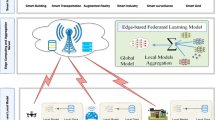Abstract
The development of the next-generation wireless networks are regarded as the essentials to embrace of Internet of Things (IoT) and edge computing in heterogeneous networks (HetNets). Due to the the spectrum scarcity problem and the large number of connectivity demand of IoT users, intelligent interference management for IoT is worthy of thorough investigation and should be well discussed with consideration on edge computing in heterogeneous networks (HetNets). Two crucial challenges in the context are: 1) placing edge cache based on dynamic request of IoT users, and 2) cache-enabled interference management with time-varying wireless channels. In this paper, we proposed smart edge caching-aided partial opportunistic interference alignment(POIA) with deep reinforcement learning for IoT downlink system in HetNets. Towards this end, the proposed scheme can update the base station (BS) cache dynamically, and then select the optimal cache-enabled POIA user group considering the time-varying user’s requests and time-varying wireless channels. To solve this problem efficiently, the reinforcement learning is exploited that can take advantage of a deep Q-learing to replace the system action. Extensive evaluations demonstrate that the proposed method is effectiveness according to sum rate and energy efficiency of IoT downlink transmission for HetNets.






Similar content being viewed by others
References
Liu D, Chen B, Yang C, et al. (2016) Caching at the wireless edge: design aspects, challenges, and future directions. IEEE Commun Mag 54(9):22–28
Sun Y, Zhou S, Xu J (2017) EMM: energy-aware mobility management for mobile edge computing in ultra dense networks. IEEE J Sel Areas Commun 35(11):2637–2646
Klas G (2017) Edge computing and the role of cellular networks. Computer 50(10):40–49
Mouradian C, Naboulsi D, Yangui S, et al. (2018) A comprehensive survey on fog computing: state-of-the-art and research challenges. IEEE Commun Surveys Tutor 20(1):416–464
Naderializadeh N, Maddahali MA, Avestimehr AS, et al. (2018) Fundamental limits of cache-aided interference management. IEEE Trans Inf Theory 63(5):3092–3107
Naderializadeh N, Maddahali MA, Avestimehr AS, et al. (2019) Cache-aided interference management in wireless cellular networks. IEEE Trans Commun 67(5):3376–3387
Zhao N, Yu FR, Jin M, et al. (2016) Interference alignment and its applications: a survey, research issues, and challenges. IEEE Commun Surveys Tutor 18(3):1779–1803
Yang HJ, Shin W, Jung BC, et al. (2017) Opportunistic downlink interference alignment for multi-cell MIMO networks. IEEE Trans Wireless Commun 16(3):1533–1548
Liu G, Sheng M, Wang X, et al. (2015) Interference alignment for partially connected downlink MIMO heterogeneous networks. IEEE Trans Commun 63(2):551–564
Wang L, Liang Q (2018) Partial interference alignment for heterogeneous cellular networks. IEEE Access 2018:22592–22601
Li W, Wang J, Zhang G, et al. (2019) A reinforcement learning based smart cache strategy for cache-aided ultra-dense network. IEEE Access, 39390–39401
Traverso S, Ahmed MH, Garetto M (2013) Temporal locality in today’s content caching: why it matters and how to model it. ACM Special Interest Group Data Commun 43(5):5–12
Zhu H, Cao Y, Wang W, et al. (2018) Deep reinforcement learning for mobile edge caching: review, new features, and open issues. IEEE Netw 32(6):50–57
Zhong C, Gursoy MC, Velipasalar S, et al. (2018) A deep reinforcement learning-based framework for content caching. In: Conference on information sciences and systems, pp 1–6
Deghel M, Bastug E, Assaad M, et al. (2015) On the benefits of edge caching for MIMO interference alignment. In: International workshop on signal processing advances in wireless communications, pp 655–659
Maddahali MA, Niesen U (2019) Cache-aided interference channels[J]. IEEE Trans Inf Theory 65 (3):1714–1724
He Y, Zhang Z, Yu FR, et al. (2017) Deep-reinforcement-learning-based optimization for cache-enabled opportunistic interference alignment wireless networks[J]. IEEE Trans Veh Technol 66(11):10433–10445
Wu P, Li J, Shi L, et al. (2019) Dynamic content update for wireless edge caching via deep reinforcement learning. IEEE Commun Lett 23(10):1773–1777
Sengupta A, Tandon R, Simeone O, et al. (2017) Fog-aided wireless networks for content delivery: fundamental latency tradeoffs. IEEE Trans Inf Theory 63(10):6650–6678
Kakar J, Gherekhloo S, Awan ZH, et al. (2017) Fundamental limits on latency in cloud- and cache-aided HetNets. In: International conference on communications(ICC), pp 1–6
Zhang J, Simeone O (2019) Fundamental limits of cloud and cache-aided interference management with multi-antenna edge nodes. IEEE Trans Inf Theory 65(8):5197–5214
Gomadam KS, Cadambe VR, Jafar SA, et al. (2011) A distributed numerical approach to interference alignment and applications to wireless interference networks. IEEE Trans Inf Theory 57(6):3309–3322
Ksentini A, Taleb T, Chen M. (2014) A markov decision process-based service migration procedure for follow me cloud. In: Proceeding in IEEE international conference on communications (ICC), pp 1350–1354
Zheng J, Li J, Wang N, et al. (2017) Joint load balancing of downlink and uplink for eICIC in heterogeneous network. IEEE Trans Veh Technol 66(7):6388–6398
Zaidi AA, Baldemair R, Andersson M, et al. (2017) Designing for the future: the 5G NR physical layer, Ericsson, Tech. Rep., Jul. [Online]. Available: https://www.ericsson.com/en/ericsson-technologyreview/archive/2017/designing-for-the-future-the-5g-nr-physical-layerhttps://www.ericsson.com/en/ericsson-technologyreview/archive/2017/designing-for-the-future-the-5g-nr-physical-layerhttps://www.ericsson.com/en/ericsson-technologyreview/archive/2017/designing-for-the-future-the-5g-nr-physical-layer
Acknowledgements
This work was supported in part by National Key R&D Program of China(2019YFC1521400), National Natural Science Foundation of China (61701400, 61672426 and 61902229), by Project Funded by China Postdoctoral Science Foundation (2017M613188), by Natural Science Basic Research Plan in Shaanxi Province of China (17JK0783 and 2019JQ-271).
Author information
Authors and Affiliations
Corresponding author
Additional information
Publisher’s Note
Springer Nature remains neutral with regard to jurisdictional claims in published maps and institutional affiliations.
Rights and permissions
About this article
Cite this article
Zheng, J., Gao, L., Wang, H. et al. Smart Edge Caching-Aided Partial Opportunistic Interference Alignment in HetNets. Mobile Netw Appl 25, 1842–1850 (2020). https://doi.org/10.1007/s11036-020-01568-6
Published:
Issue Date:
DOI: https://doi.org/10.1007/s11036-020-01568-6




